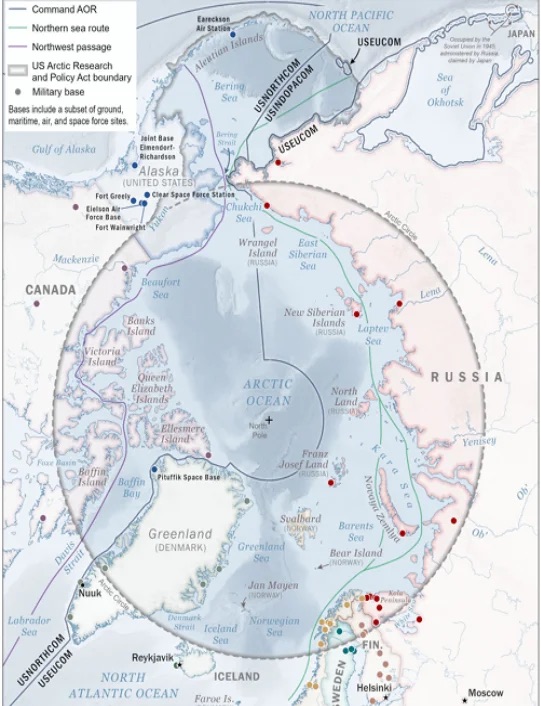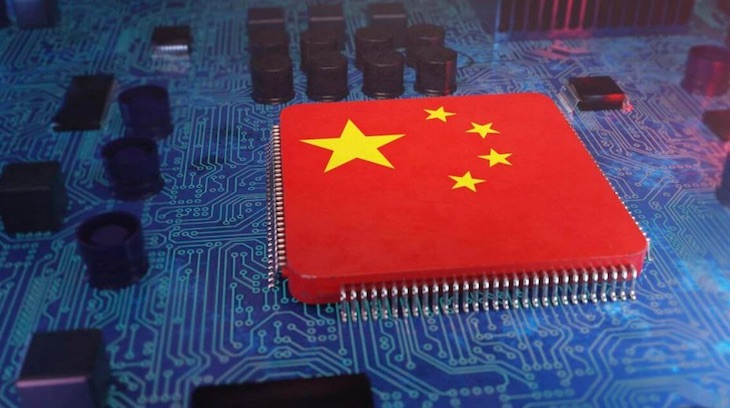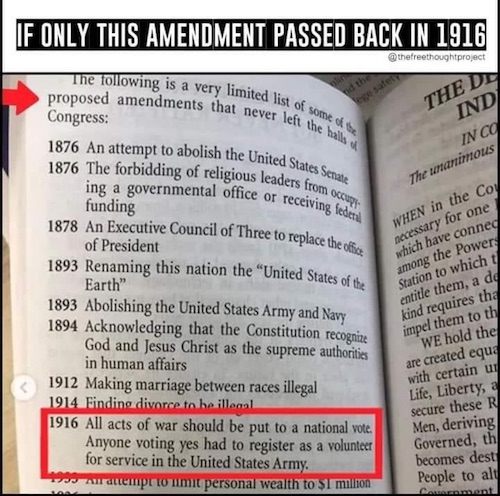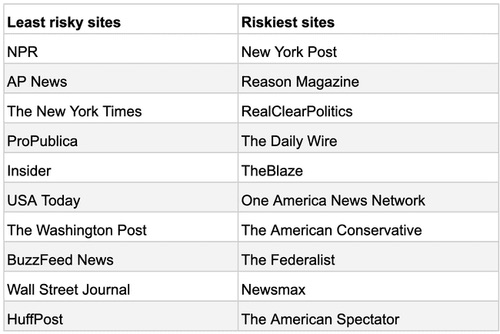
Edward Hopper The Lee Shore 1941



Rickards
🚨 TRUMP’S $150 TRILLION PLAN: THE TRUST FUND HIDDEN FOR 161 YEARS 🚨
🔴 Jim Rickards drops a bombshell:
🗣️ “Trump is preparing to unlock a $150 TRILLION natural trust — buried under U.S. soil for 161 years.”
🔴 This is America’s silent inheritance — copper, lithium, rare… pic.twitter.com/25O58PqO1u— Jim Ferguson (@JimFergusonUK) April 21, 2025
112
🚨Information: Death of the 112th Pope will lead to Judgment Day in 2027 — a 12th century prophecy of St. Malachy!
Pope Francis is precisely the 112th Pope, after whose death the 'seven-hilled city will be destroyed, and the dreadful Judge will judge the people. The End!’
Are… pic.twitter.com/oxWNA7aR4u
— US Homeland Security News (@defense_civil25) April 21, 2025
O’Leary
O’LEARY: “These tariffs are not going to be forever … Let this administration get this thing done and let's move on. Because the last 20 administrations never dealt with it. This one is … You may have Trump Derangement Syndrome. I don't care. Because that's not what matters.”… pic.twitter.com/5LBth5YfgU
— Chief Nerd (@TheChiefNerd) April 21, 2025
Thiel
Peter Thiel: In the 2000s, people thought Elon was really crazy.
“When Elon was building both Tesla and SpaceX in the 2000s, people thought he was just really, really crazy, even a lot of those of us who'd worked with him at PayPal.
There was this PayPal book that David Sacks… pic.twitter.com/YdfggrzkEh
— ELON CLIPS (@ElonClipsX) April 21, 2025
Tucker
Tucker Carlson tells Alex Jones that a false flag attack disguised as a fight against “racism” will be used to permanently shut down free speech on social media.
He says people will be manipulated into giving up their rights under the pretense of safety.
He says certain… pic.twitter.com/Cp0vMVnyEO
— Shadow of Ezra (@ShadowofEzra) April 21, 2025


Trump shuts down all potential communication lines between him and Xi. Except for those he wants. Direct line. Call me.
• Trump Wants Direct Talks With Xi – Politico (RT)
US President Donald Trump has stifled almost every channel of diplomatic outreach with China, aiming to deal directly with his Chinese counterpart Xi Jinping, as the trade war between the two superpowers escalates, Politico has reported citing anonymous sources. The increasing tit-for-tat duties between the US and China is part of a broader US tariff campaign against more than 90 countries, said to be aimed at addressing unfair trade imbalances. While Trump has paused the hikes for most countries for 90 days, Beijing was excluded and faces a 145% tariff. China has retaliated with 125% tariffs on US goods and restricted certain key exports. The US president is adamant about direct negotiations with Xi, and has stifled other diplomatic avenues, Politico wrote on Saturday, citing anonymous former US State Department officials and an industry official.
Trump has not authorized White House delegates to engage with Beijing, the outlet cited its sources as saying. In addition, the Senate has not confirmed a US ambassador to China, Trump has not nominated an official to lead a diplomatic effort, and Washington has thus far not reached out to the Chinese embassy, Politico reported. “The backchannels don’t work because President Trump doesn’t want them to,” Ryan Hass, former director for China, Taiwan, and Mongolia at the National Security Council during the Obama administration, told the outlet. “Trump wants to deal directly with President Xi in the same way he has with [Russian President Vladimir] Putin,” he said. Washington is waiting for Beijing to reach out and call first, CNN wrote earlier this month, citing anonymous officials.
“China wants to make a deal. They just don’t know how quite to go about it,” Trump has said. “They’re proud people.” Additionally, Washington intends to use negotiations over potential tariff exemptions to pressure US trading partners to curb their ties with China and ramp up pressure on Beijing, the Wall Street Journal reported last week, citing unnamed sources. In a statement on Monday, the Chinese Commerce Ministry stressed that it would retaliate against any country that takes such a deal “at the expense of China’s interests.”

Memories of all the roads to nowhere and the giant empty apartment buidings a few years ago.
• China Is In Economic Dire Straits And They’re No Longer Able To Hide It (ZH)
Official economic data from any government is always treated with suspicion by anyone with common sense. The US, for example, witnessed some of the most egregious statistical tinkering imaginable under the Biden Administration, not to mention outright lies and propaganda from the establishment media on the health of the economy. To this day no one has been fired (or tarred and feathered) for hiding the reality of the stagflation crisis. Any government or corporate economist that called the threat “transitory” should be stripped of their financial prestige and banished to a cash register at Arby’s. And let’s not forget Biden’s misrepresentation of the labor market, portraying millions of new jobs for illegal migrants and visa holders as if they were jobs benefiting American citizens. In the US and across the western world, lying about the economy is generally seen by politicians as a temporary solution to secure reelection.
However, in China, lying about the economy is treated as a national security imperative. If there’s anything in the world that gives communists a feeling of existential dread, it’s the fear that their ideological enemies will discover proof that communism doesn’t work. The Trump Administration’s tariffs on China are not the initiator of the nation’s troubles, they are more a bookend to a process of decline that has been ongoing for years. Overall tariffs on Chinese goods currently sit at 124%, but some goods will be taxed as high as 245%. Trump has given a 1 month exemption on electronic parts and devices, perhaps to offer manufacturers like Apple, Nvidia and Microsoft time to arrange sourcing from alternative vendors. The problem for Chinese manufacturers is not just the tariffs but the uncertainty of timing and sudden changes to policy. They say no one is willing to make a big move on production or shipments until the trade landscape becomes more predictable. This means most Chinese factories are frozen in stasis.
Trump’s tariff actions are widely criticized by the media as erratic or poorly planned, but what they don’t understand is that uncertainty is the real leverage, not the tariffs. What seems like a spur of the moment decision or a sudden capitulation on Trump’s part can be highly effective at throwing foreign governments and corporations off balance. Globalism requires a perpetual status quo, change of any kind is like holy water to a vampire. Chinese shipments are on standby and orders are frozen. Nothing is moving. At bottom, China will not be able to survive tariffs on the current scale for long (a single year of 124% tariffs would crush China’s economy beyond repair). The US is 15% of China’s export market, which may not sound substantial but their next largest trading partner (outside of Hong Kong) is Vietnam at 4% of exports.
In terms of domestic buying, China is 11% of the global consumer market which is not too shabby, but compared to the US with its 30%-35% global consumer market share there is no chance that the Chinese will be able to fill the void domestically and stay afloat. But the situation is far worse than most people know… China has been suffering from a deflationary crisis since 2023. An uptick in exports during the pandemic was offset by the CCP’s draconian lockdowns. This was, essentially, fiscal suicide on the part of the government and China has been struggling ever since. Their property market has imploded, partially due to overbuilding through government subsidized infrastructure programs that flooded the market with poorly constructed homes and buildings that were then left to rot. Corporate defaults have run rampant and left investors with nothing.
There was some optimism that the government’s measures to end the crisis had been working to reinvigorate the market, but on Mar 31st, government-linked developer Vanke reported a record 49.5 billion yuan (S$9.1 billion) annual loss for 2024. It’s the company’s first full-year loss since its initial public offering in 1991, reigniting concerns about the sector and showing just how deep the problem runs. When these projects do finally see some progress it is often due to dangerously poor construction standards and subpar workmanship; what many now refer to as “Tofu Dreg” buildings. The deflationary spiral has been eating away at employment and has also resulted in numerous factories refusing to pay their workers on time (or at all). Unpaid wages are leading to frequent protests and a disturbing trend of factory fires. The government is limited in how it can respond to the problem. Stimulus is an option, but China’s overall non-financial debt is well over 300% of GDP already.
China’s attempts to hide the decay from the outside world are becoming less and less effective. With Chinese citizens able to access the internet beyond the “Great Firewall”, more and more videos are being leaked by people within the country who are tired of the misinformation. Again, the CCP views negative economic data as a national security threat and any citizen caught leaking this info could be subject to harsh punishment. Chinese citizens have taken substantial risks to get the truth out there. It cannot be stressed enough that the global economy is largely a farce, but China is closest to the edge of the cliff in terms of consequences and crisis. The interdependency of globalism has left many nations without the ability to weather a trade dispute and China’s survival is almost entirely based on steady exports to the west and the US in particular. Don’t let high paid TikTok and YouTube influencers fool you with videos of Chinese skyscrapers caked with LED lights or lavish parties with dancing robots. This is not the true China. Underneath the facade is a nation on the brink of disaster.

China tries to export to US via Vietnam because of tariffs. Easy to shut down.
• China’s Gray Trade Strategy Blunts Impact of US Tariffs (Gorrie)
Is a new boom in deceptive trading practices taking shape in many parts of the world? As the U.S.–China trade war intensifies, it certainly looks that way. With U.S. tariffs reaching 145 percent on Chinese imports—at least at the time of this writing—Beijing’s new strategy seems to include the use of so-called gray trade to bypass American trade barriers. Gray trade involves rerouting goods through low-tariff countries, such as Vietnam, Mexico, or Malaysia, to conceal their Chinese origin and thereby reduce U.S. import duties. This sneaky tactic has surged as a response to President Donald Trump’s aggressive tariff policies, making China’s goods less competitive in the U.S. market due to their added cost.
Gray Trade Loophole Strategy The simple idea behind gray trade is to exploit loopholes in U.S. Rules of Origin, the trading guidance for determining a product’s country of origin for tariff purposes. Chinese goods, for example, will remain unassembled or may be about 90 percent manufactured before being shipped to an intermediary country. There, they undergo final production, assembly, processing, repackaging, or relabeling to qualify as originating from that country, rather than from China. For example, Chinese electronic parts may be sent to Vietnam, assembled into a product, and then labeled, “Made in Vietnam.” This enables China to benefit from the 10 percent tariff on Vietnamese imports under Trump’s 2025 reciprocal tariff regime, instead of the 145 percent tariffs on Chinese goods. It’s a perfectly sensible response by Beijing, and there’s no doubt that Chinese firms are rerouting goods through Vietnam, Mexico, and Turkey to exploit lower tariffs on goods sourced from those countries. A related tactic occurring in Mexico involves dividing goods into packages that are below the $800 tariff-free threshold for non-Chinese origins, a tactic called the “Tijuana two-step.”
China Has to Resort to Gray Trade But gray trade isn’t new or even unfamiliar to the second Trump administration. During Trump’s first term, Chinese solar manufacturers bypassed 30 percent tariffs by partnering with their neighbors in Southeast Asia. In 2025, tracing the movement and provenance of vast numbers of products is complex at best and nearly impossible at worst, making it a challenge to disrupt gray trade. It’s no mystery why Beijing is engaging in gray trade. With its exports to the United States accounting for 10 percent of its trade and supporting between 10 million and 20 million jobs, some experts say the world’s largest manufacturer faces an estimated 80 percent decline in its exports over the next two years, if the gray trade were to cease.
As domestic economic conditions decline due to the anticipated extensive trade tensions, China’s 2025 GDP projections have fallen from 5 percent to as low as 4 percent, potentially resulting in a 20 percent drop in GDP growth in just one year. With joblessness among its young people (ages 16 to 24) already approaching 17 percent, the Chinese Communist Party (CCP) faces a growing resentment among its people. The Party would like to avoid an uprising by its younger generation. The gray trade has provided a much-needed cushion against the blow of the Trump administration’s high tariffs. For instance, according to official data, China’s exports surged by 12.4 percent in March, with exports to ASEAN increasing by 11.6 percent and exports to Vietnam climbing by nearly 19 percent.
Impact on Low-Tariff Countries But it’s not just China that gains from gray trade. Its low-tariff country partners also gain economically from gray trade but face risks, too. Gray trading partners, such as Vietnam, Malaysia, and Mexico, profit from trade and processing fees, with some estimates on the social media platform X reaching as high as 10 percent. It’s worth noting that between 2017 and 2022, Vietnam replaced almost half of China’s lost market share in U.S. imports. However, gray trading partner countries risk the consequences of U.S. pushback, resulting in a delicate balancing act for these countries caught between gray trade with China and managing important trading relationships with the United States.
Economic and Geopolitical Implications Economically, gray trade preserves China’s U.S. market access for the moment, but it raises costs as intermediaries take their cut, with logistics costs also increasing. For U.S. consumers, it may delay steep price hikes, but won’t eliminate them. Geopolitically, Beijing’s retaliatory 125 percent tariffs on U.S. goods, plus adding barriers to U.S. beef and LNG imports, raise tensions even higher. CCP leader Xi Jinping’s recent visits to Vietnam, Malaysia, and Cambodia could have secured their gray trade hubs going forward.
But the impact of gray trade is perhaps deeper and wider than many may expect. On the one hand, it’s a reasonable response on China’s part to U.S. tariffs. But on the other hand, there are greater risks. The United States could expand tariffs or use the International Emergency Economic Powers Act (IEEPA) to close loopholes. That, too, may be a rational response by the United States, or it could make things worse. “The global trade system for the past ninety years is collapsing, leaving it difficult for people to forecast the economic impact and tell where the bottom for a market is,” Vincent Chan, a China strategist at Aletheia Capital Ltd., told Bloomberg. As new phases of U.S. trade policy and responses unfold, the biggest risk may be uncontrolled escalation in both tariff retaliation and other forms of retaliation. In short, the impact of the gray trade may be deeper and wider than many expect, and it could even lead to a global trade war, with its own far-reaching implications.

Pepe is in China and in love.
• The Shanghai Spirit – China Will Take No Bullying (Pepe Escobar)
There could not be a more strategic place to spend these past Trump Tariff Tizzy (TTT) heady days than in Shanghai – China’s trade, commercial and cultural capital. From the top of the Jin Mao tower in the world class Lujiazui financial district in Pudong, an elegantly discreet art deco companion to the World Financial Center super-skyscraper – the trademark symbol of China’s economic power – it’s as if the spokes of a wheel radiated to the Bund and beyond tracking a ceaseless drive to counteract the absurd idiocy of the “Emperor of Tariffs”, relentless mocked across myriad Chinese social media platforms. I have had the privilege to transit from the Bund Financial Center, which hosts among others the Fosun Foundation – a bamboo-inspired architectural masterpiece – to the China Academy at the immaculate campus of Fudan University, where I shared a seminar with star professor Zhang Weiwei and a round table with top PhD students from several disciplines. Professor Zhang Weiwei is the foremost conceptualizer of China as a civilization-state.
The key theme of our seminar was the Russia-China strategic partnership, but inevitably the focus switched back and forth to the rationale behind the Emperor of Tariffs. The questions from the students were as sharp as they come. That was compounded with an in-depth interview for China Academy hosted by their CEO, the formidable Pan Xiaoli. A visit to the HQ of Guancha – the top independent new/analysis site in China, whose several channels in several different platforms reach an astonishing 200 million people – could not have been more timely. Guo Jiezhen, a research fellow from the China Institute, who was part of our round table at Fudan University, came up with one of the more astute analyses of what he describes as Trump’s “deranged money-making technique”.
While meeting with Guancha’s new editor-in-chief He Shenquan and discussing with hyper-competent international relations specialist Kelly Liu and Yang Hanyi – the China Institute’s communication officer – we watched together an exceptional podcast featuring PLA Colonel Wang Lihua, Gao Zhikai – Deputy Director of the Center for China and Globalization (CCG) – and the always essential Li Bo, President of the Shanghai Chunqiu Development Strategy Institute. And that’s when Mao Zedong’s legendary 1960s formulation of the US as a “paper tiger” – quoted in everything from Latin American guerrilla slogans to Godard movies – resurfaced with full force. Wang Lihua picked up on what President Xi had told Putin at their landmark meeting at the Kremlin two years ago: we are right in the middle of changes not seen in 100 years. Wang: “This change cannot be changed all at once, and the trade war between China and the United States will not be resolved once and for all. This kind of friction and struggle, in the words of Chairman Mao, is ‘making trouble, failing, making trouble again, failing again, until destruction.’”
Wang wrapped up with what may encapsulate the general feeling in China, identified in every nook and cranny across Shanghai: “It is difficult for the United States to repair itself from within. Now the United States has to confront China and the whole world, and its strength is obviously not enough, so failure is inevitable. We are not afraid of a protracted war, because time is on our side.” China “not afraid of war”, however it may manifest itself, from hybrid to hot, is the consensus feeling in Shanghai, borrowing from the Maoist concept of “united front”, and espoused from academics and business leaders to residents of “model quarters” of the Maoist era still impeccably preserved – and with an eye for innovation (example: row after row of a.c. outlets to feed the array of electric bikes parked in the internal patios).

Hard bargain.
• Trump Wants Piece Of Russia Claimed By Kiev – WSJ (RT)
The US intends to assert control over the Russian territory surrounding Europe’s largest nuclear power plant as part of a mediated agreement between Kiev and Moscow, according to the Wall Street Journal. The proposal is part of a reported package of options that the US expects Ukraine to respond to by the end of this week. Last Thursday, senior members of US President Donald Trump’s administration met with Ukrainian and European officials in Paris. One of their ideas aimed at facilitating a peace agreement between Kiev and Moscow involves designating the land around the Zaporozhye nuclear power plant (NPP) as neutral territory under US control, the newspaper reported Sunday, citing anonymous sources. The former Ukrainian region hosting the facility voted to join Russia in 2022, though Kiev has dismissed the referendum as a sham.
In March, Trump claimed that Ukraine’s Vladimir Zelensky had proposed that the US take ownership of his country’s nuclear power plants. Zelensky, however, refuted this assertion, stating that he and Trump only discussed potential US investments in the Zaporozhye NPP. Additionally, Washington has suggested recognizing Russian sovereignty over Crimea, not opposing Russian control over four other former Ukrainian regions, including Zaporozhye, and rejecting Ukraine’s bid for NATO membership, according to the WSJ. However, the list of proposals does not include any cap on the strength of the Ukrainian army or ban on troop deployments by European NATO members in Ukraine, the newspaper noted. If the US, its European allies, and Ukraine achieve a “convergence” this week, the package will be presented to Moscow, the WSJ reported.
Moscow has firmly rejected any proposed NATO presence in Ukraine and has asserted that the Istanbul agreement — a truce proposal negotiated in 2022 that includes limitations on the Ukrainian military — should serve as the foundation for a future peace accord. This plan was rejected by Kiev following intervention from then-British Prime Minister Boris Johnson. Russia has accused the EU and the UK of attempting to undermine Trump’s mediation efforts in order to prolong the conflict in Ukraine. The US president has cautioned that his administration would “just take a pass” if the diplomatic effort becomes too challenging.

“We cannot give everyone a trial, because to do so would take, without exaggeration, 200 years..”
“What a ridiculous situation we are in..”
• Trump Slams Supreme Court Over Blocking Deportations (JTN)
President Donald Trump on Monday slammed the United States’ court system, including the Supreme Court, over their response to his efforts to deport illegal migrants, stating it is “not possible” to try every person who is in the U.S. illegally. The Supreme Court over the weekend temporarily blocked Trump’s latest round of deportations under the 1798 Alien Enemies Act. Trump’s deportations have come under scrutiny after he removed hundreds of illegal migrants he accused of being gang members without due process. The president defended his actions in a post on Truth Social, claiming it would take “200 years” to try every illegal migrant, and slammed the Supreme Court for allegedly not wanting him to “send violent criminals and terrorists back to Venezuela.”
“I’m doing what I was elected to do, remove criminals from our Country, but the Courts don’t seem to want me to do that,” Trump wrote in the post. “My team is fantastic, doing an incredible job, however, they are being stymied at every turn by even the U.S. Supreme Court, which I have such great respect for, but which seemingly doesn’t want me to send violent criminals and terrorists back to Venezuela, or any other Country.” The president praised Supreme Court Justice Samuel Alito’s dissent, stating the justice was right for wanting to “dissolve the pause on deportations.” “If we don’t get these criminals out of our country, we are not going to have a country any longer,” Trump insisted. “We cannot give everyone a trial, because to do so would take, without exaggeration, 200 years. We would need hundreds of thousands of trials for the hundreds of thousands of Illegals we are sending out of the country. Such a thing is not possible to do.
“What a ridiculous situation we are in,” he concluded.

“Millions of immigrant-invaders can enter America illegally, but they cannot be deported until they have had their day in court..”
“The deportation hearings, which will be shopped to Democrat district and appeal courts, will take years and will not be resolved until Trump’s term is over.”
• Do You Prefer White Liberal States To Hispanic States? (Paul Craig Roberts)
Like Trump’s on-off-on tariffs, the US Supreme Court’s rulings are off-on-maybe-we will see. Last week the Court overruled Boasberg and said that Trump had the authority to deport illegal aliens. But by the time last Saturday arrived, the Court had changed its mind and “paused” the deportation of illegal entrants. The Court now has decided that those who had entered the US illegally, thus committing a crime, had the right to challenge their deportation in US courts.Here is the Supreme Court’s ruling: “The government is directed not to remove any member of the putative class of detainees from the United States until further order of this court.” Note the Court’s use of the word “putative.” The Court is saying that it is uncertain that the illegals are illegals. Once you have walked in, you are an American, right? That seems to be the Democrats’ position. What will the Court’s position be?
Amazing, isn’t it. Millions of immigrant-invaders can enter America illegally, but they cannot be deported until they have had their day in court. To be clear, what the US Supreme Court has ruled is that there will be no further deportations. The 16 or 30 million, or whatever the figure, illegal entrants are here to stay. The deportation hearings, which will be shopped to Democrat district and appeal courts, will take years and will not be resolved until Trump’s term is over. For decades American conservatives have thought that the most important reason to have a Republican president is Supreme Court Appointments, but now we see it matters not to have a Republican majority on the Supreme Court. The Court, whether Republican or Democrat, has no comprehension of American survival. The courts are preoccupied with grabbing power from the executive.
Just as the US took Texas, Colorado, California and the SouthWest from Mexico, the hispanics are taking it back with the aid of the Democrat Party and the US Supreme Court. And, of course, with the acquiesce of Republicans who are incapable of fighting. The question is: how much do we really care? Would you prefer to have white liberal Colorado, California, Arizona or Hispanic Colorado, California, and Arizona. I would prefer the Hispanics. They are more decent people than white liberals, and, unlike white liberals, they do not hate America. Perhaps the ignorant insouciance of the American courts will have the unintended result of replacing anti-American blue states with Hispanic states. It would be a huge improvement in the quality of America.

Sergei Poletaev.
• Trump Wants A Deal. Putin Wants Victory. Ukraine Will Get What It Deserves (RT)
The Easter ceasefire has come and gone, with Russia and Ukraine trading accusations over thousands of violations as fighting resumes across the front lines – yet another reminder of how difficult it is to bring this war to an end. Amid the renewed hostilities, Donald Trump’s long-promised peace plan is colliding with geopolitical realities. Despite backchannel talks with the Kremlin and growing pressure from both allies and opponents, Trump has yet to produce a deal that doesn’t resemble capitulation – or undermine his own political standing. With a new offensive looming and patience wearing thin, the real question now is whether peace is still on the table – and if so, on whose terms.
The Relentless Push for Peace The fundamental difference between President Donald Trump and his predecessor, Joe Biden, is that Trump is genuinely trying to negotiate a meaningful peace with Russia. He has no interest in prolonging what he sees as a losing war inherited from Biden, and he’s determined to end it. But he also knows he can’t accept just any deal – he needs a version of peace that won’t look like a defeat. After all, his critics are ready to frame any compromise as his own personal Afghanistan.That’s the framework Trump is working within. What motivates Russian President Vladimir Putin isn’t really a top concern for him. So, he sends a trusted confidant – Steve Witkoff – to explore the possibility of striking a deal with the Kremlin. In his meeting with Putin, Witkoff likely hears the same hardline message the Russian leader shares in public – and, reportedly, in private calls with Trump: lasting peace can only be achieved on Moscow’s terms.
At a minimum, that means reviving the Istanbul agreements with additional territorial concessions. At most, it involves Russia’s sweeping 2021 demands to redraw Eastern Europe’s security architecture and, in effect, reverse the legacy of the Cold War. It also seems Putin thinks he can secure at least his minimum objectives through brute force. Whether he’s bluffing or not, he’s clearly using the threat of escalation to pressure Trump. The message is implicit: Worried that Ukraine’s collapse will be blamed on you? There’s one way to prevent that – make a deal with me. In return, Trump could preserve face, gain economic wins like Nord Stream 2, and claim peace during his term. Meanwhile, Putin gets what he really wants: a thaw in US-Russia relations, an end to sanctions, and, crucially, legitimization of Russia’s actions in Ukraine. And if future conflicts arise, he’ll be in a stronger position. Not to mention, it would strike a blow against the globalists – an enemy both men seem to share.
That’s the pitch Putin’s been making, and by all indications, it’s what he and Witkoff discussed in their five-hour meeting. Witkoff, for his part, appears to be on board – he said as much during a Fox News appearance on April 15. But the final call rests with Trump, not Witkoff. And Trump faces a difficult challenge: even if he wants to make a deal, how can he ensure it sticks? It’s not just Ukraine and Europe trying to sabotage the talks – that was to be expected – but opposition is also coming from inside Trump’s own camp. Take Keith Kellogg, for example. He might tell Trump that Ukraine will never accept any such agreement. He could argue that Europe is fully aligned with Kiev and that if Trump really wants peace, he’ll need to get Putin to accept a European military presence in Ukraine. You want peace? Here’s the map – go make it happen.
Then there’s Secretary of State Marco Rubio, who may quietly but firmly advance the globalist view: any peace must be on Western terms, not Russian ones. He might even bring a fresh round of sanctions and another military aid package for Ukraine to the table. It’s a situation reminiscent of 2016. Back then, Trump had seemingly cordial relations with Putin but ended up expanding anti-Russia measures due to domestic constraints. Today, his political position at home is stronger – but so are the stakes.

EU knows no shame.
• Putin Reacts To EU Threats On Victory Day (RT)
Russian President Vladimir Putin has commended the courage of European leaders who choose to come to Moscow for events commemorating the 80th anniversary of victory in World War II, despite pressure on them from EU officials.Last week, the bloc’s top diplomat and former Estonian prime minister, Kaja Kallas, warned the leaders of EU member and candidate states against flying to Russia to take part, recommending instead that they visit Kiev to show solidarity with Ukraine. Other EU officials have reportedly threatened to derail membership bids for candidate countries whose leaders defy Brussels on the matter. Journalists asked Putin to comment on the reports after the All-Russian Municipal Service Award ceremony in Moscow on Monday.
“Those who are going to come to Russia have much more courage than those who are hiding behind someone’s back and trying to threaten others,” he replied.“In this case, [threatening] those who are going to celebrate the historical merits of people who gave their lives in the fight against Nazism,” Putin said. According to Kallas, participation in this year’s events in Moscow “will be not taken lightly.” Slovak Prime Minister Robert Fico, the only EU member state leader who has promised to attend, blasted the statement as outright “disrespectful.” “Is Ms. Kallas’s warning a form of blackmail or a signal that I will be punished?” he wrote on X last week. “The year is 2025, not 1939,” he added.
The president of EU candidate Serbia, Aleksandar Vucic, similarly indicated that he would not change his plans in the face of pressure from Brussels. “I have not changed my decision… Eight months ago, I announced my visit to Moscow, publicly,” he said last week, according to Serbian media.Moscow has extended multiple invitations to this year’s landmark celebrations, including to the heads of China, India, and Brazil, as well as a number of other international leaders. Victory Day is one of the most important national holidays in Russia. The event is celebrated annually on May 9 to mark the 1945 triumph of the USSR over Nazi Germany and its allies, and to honor the estimated 26.6 million deaths the Soviet Union suffered in World War II. Around 18 million were civilian deaths.

Recently Hegseth, JD Vance, Tulsi Gabbard and Susie Wiles voted against bombing Iran. Three Pentagon staff departed. This is the result. Usual suspects: NPR, NYT, Politico et al.
• Is a Coup Against Pete Hegseth Brewing at the Pentagon? (Margolis)
Something tells me that the liberal media is trying to force Secretary of Defense Pete Hegseth from the Pentagon. According to a report from Politico, the Pentagon has become a “chaotic” mess because of Hegseth’s alleged influence, and it’s becoming a problem for the administration. “It’s been a month of total chaos at the Pentagon. From leaks of sensitive operational plans to mass firings, the dysfunction is now a major distraction for the president — who deserves better from his senior leadership,” the article claims. “President Donald Trump has a strong record of holding his top officials to account. Given that, it’s hard to see Defense Secretary Pete Hegseth remaining in his role for much longer.” It’s a claim so ludicrous that you almost have to appreciate the creative writing involved. What’s the evidence? A few anonymous complaints and a spin cycle that would make a laundromat envious.
John Ullyot, the writer of the article, claims that he’s a Hegseth supporter, yet the Pentagon recently asked him to resign. So I’m sure he doesn’t have an axe to grind. But let’s take a look at what he’s claiming anyway. According to Ullyot, the Pentagon “is in disarray under Hegseth’s leadership.” Curiously, to prove his point, he cites the “Signalgate” kerfuffle as evidence of the chaos, not the successful mission against the Houthi rebels in Yemen. Despite his repeated claims of supporting Hegseth, his narrative sounds like it was lifted straight from the Democrat playbook. I suspect he leans on his supposed backing of Hegseth not out of conviction, but as a shield to lend credibility to what amounts to a repackaged left-wing hit job on the Pentagon.
“Yet even strong backers of the secretary like me must admit: The last month has been a full-blown meltdown at the Pentagon — and it’s becoming a real problem for the administration,” Ullyot writes. Let’s not pretend that this isn’t orchestrated. The timing is telling. Hegseth has been critical of the Biden administration’s dismal defense policies, exposing its failure to prioritize American security interests. And now, as if by magic, Politico drops a hit piece linking him to alleged dysfunction at the Pentagon by a “friend.” Give me a break. He sounds like the next Omarosa. We saw this play out during Trump’s first term, and it looks like it’s happening all over again — figures who claim to support the president suddenly breaking ranks “for the greater good.” But scratch the surface, and it’s clear that they’re serving as mouthpieces for the deep state, trying to create the very dysfunction and chaos they claim already exists.
It’s a classic tactic: create the chaos, then point to it as proof they were right all along. Ullyot claims that “There are very likely more shoes to drop in short order, with even bigger bombshell stories coming this week, key Pentagon reporters have been telling sources privately.” Ahhh, sources. If anything, this article proves one thing: the left and their media enablers are running scared. So let’s call the situation what it is. Politico isn’t reporting the news; it’s trying to shape it. Hegseth stands for values that terrify the liberal elite: strength, accountability, and an America-first mindset. And that’s why the left is working so hard to undermine him, even if it means stretching the truth to the breaking point to create chaos.

Hegseth survived phase 1. That emboldened him, also because it shows Trump’s trust and loyalty.
• Hegseth Slams Media Over Latest Smear Campaign: ‘Full of Hoaxsters’ (Margolis)
Secretary of Defense Pete Hegseth didn’t hold back when asked about the latest media-driven controversy involving internal Signal messages and supposed leaks from the Pentagon. Speaking during the White House Easter Egg Roll, Hegseth delivered a scathing rebuke of the press, accusing it of orchestrating a smear campaign using anonymous sources and recycled narratives. “What a big surprise,” Hegseth said, when asked about the so-called “Signal chat controversy.” “A few leakers get fired and suddenly a bunch of hit pieces come out from the same media that peddled the Russia hoax. They got Pulitzers for a bunch of lies — Pulitzers for a bunch of lies, and on hoaxes, time and time again.” Hegseth wasn’t finished. As reporters tried to pepper him with more questions, he tore into what he sees as the media’s standard operating procedure: relying on unverifiable leaks and turning them into politically motivated attacks.
“This is what the media does,” he said. “They take anonymous sources from disgruntled former employees and then they try to slash and burn people and ruin their reputations.” “But it’s not gonna work with me,” he added defiantly. “Because we’re changing the Defense Department. We’re putting the Pentagon back in the hands of war fighters, and anonymous smears from disgruntled former employees on old news doesn’t matter.” Former Pentagon official John Ullyot, who was recently asked to resign, just penned a thinly veiled hit piece in Politico claiming that the Pentagon has descended into “chaos” and predicting that Hegseth’s ouster is imminent. The article leans heavily on anonymous sources and paints a conveniently damning picture that plays right into the hands of the deep state.
It’s a familiar playbook: pose as a concerned insider while amplifying the very narrative the left wants to push. The timing is no accident. These attacks are surfacing just as Hegseth is aggressively working to clean house, purge entrenched bureaucrats, and return the Pentagon to the control of actual warfighters. This isn’t genuine concern; it’s a coordinated attempt to take down an outsider who refuses to play by their rules. As the secretary stood alongside his father and his children, he reminded reporters what motivates him. “This is what we’re doing it for. These kids right here. This is why we’re fighting the fake news media. This is why we’re fighting slash-and-burn Democrats. This is why we’re fighting hoaxsters.” When one reporter tried to interject with another question, Hegseth cut through the noise.
“This group right here,” he said, pointing toward the assembled press, “full of hoaxsters that peddle anonymous sources from leakers with axes to grind. And then you put it all together as if it’s some news story.” Despite the media’s coordinated efforts to generate controversy, Hegseth made it clear he isn’t backing down.“I’m really proud of what we’re doing for the president — fighting hard across the board,” he said before heading off to enjoy the Easter event with his family. “I’ve spoken to the president, and we are gonna continue fighting on the same page all the way.” In typical fashion, the media tried to create a scandal. But in Pete Hegseth, they’ve found someone unafraid to punch back.
REPORT: Karoline Leavitt Just Blew the Lid Off the Pentagon’s War on Pete Hegseth
In a bombshell statement, Karoline Leavitt revealed what many have suspected for weeks:
“The entire Pentagon is working against you and working against the monumental change that you are trying to… pic.twitter.com/PNVBEe0B4H
— The Vigilant Fox 🦊 (@VigilantFox) April 22, 2025

24 years ago.
• US Senator Ron Johnson Says New 9/11 Investigation Could Happen (RT)
Republican Senator Ron Johnson has suggested that new congressional hearings into the September 11 attacks may be forthcoming, citing unanswered questions surrounding the official narrative and the handling of evidence. On September 11, 2001, al-Qaeda terrorists hijacked four passenger airliners, crashing two into the World Trade Center towers in Manhattan. A third plane struck the Pentagon, while the fourth crashed into a field in Pennsylvania. According to the National Institute of Standards and Technology (NIST), World Trade Center Building 7 collapsed due to fires ignited by debris from one of the nearby towers. During an interview with conservative commentator Benny Johnson published Monday, Senator Johnson questioned several aspects of the 9/11 investigation, including the collapse of Building 7.
“I don’t know that you can find structural engineers – other than the ones that have the corrupt investigation inside NIST – that would say that that thing didn’t come down in any other way than a controlled demolition,” he said. Johnson, who chairs the Senate Homeland Security and Governmental Affairs Permanent Subcommittee on Investigations, also criticized the removal and destruction of physical evidence from the site, calling it “totally contrary to any other firefighting investigation procedures.” “Where’s all the documentation from the NIST investigation? There are a host of questions that I want and I will be asking, quite honestly, now that my eyes have been opened,” he added. When asked whether the public might see hearings on the issue, Johnson replied, “I think so.”
He further suggested that President Donald Trump, “being a New Yorker himself,” might have an interest in reopening the case: “What actually happened in 9/11? What do we know? What is being covered up? My guess is there’s an awful lot being covered up in terms of what the American government knows about 9/11.” Johnson also said he recently spoke with former Congressman Curt Weldon and plans to “work with him to expose what he’s willing to expose.” Earlier this month, Weldon urged Trump to appoint “people of impeccable integrity” to lead a commission to “study the facts” surrounding 9/11.
In an interview with journalist Tucker Carlson, Weldon dismissed the label of conspiracy theorist, suggesting that the CIA and the government have long engaged in disinformation. “You know, what gets me is reporters who call people conspiracy theorists. Well, that’s all the agency does! They’re the ones who create the conspiracies,” he said. “They have whole courses for their agents on how to make people look like they’re conspiracy theorists.” The 9/11 Commission Report, released in 2004, remains the most comprehensive federal review of the attacks. However, critics have pointed to omissions and the continued classification of key government documents. Johnson also referenced a bipartisan effort with Senator Richard Blumenthal (D-Conn.) in 2023 to obtain unredacted FBI files. “We wanted to get those answers, those documents for the families. Again, we didn’t get squat from the FBI,” he said.

January: Conservatives polled 92.5%. April, 3 months later, they poll 38%. ¿Perqué? A very fertile breeding ground for TDS.
• Canada’s Conservatives See A Reversal of Fortune (JTN)
Before Canadian Prime Minister Justin Trudeau stepped down in favor of Mark Carney, Canada’s Conservative Party was expected to streamroll the national elections and overturn more than a decade of far-left liberal leadership. But under Pierre Poilievre, the Conservatives have seen their electoral prospects fall off a cliff as he has struggled to meet the moment and galvanize his supporters on a promise of tangible change. Betting markets currently hand Carney a 76.6% chance of winning the election, to Poilievre’s 23.3%. The figure represents a stunning reversal from mid-January, when Poilievre was assigned a 92.5% chance of winning. The Canadian Broadcast Corporation’s current polling shows Carney’s Liberal Party with 43.2% support, while Poilievre and the Conservatives trail with 38.0%.
Canada is a multi-party parliamentary democracy that often sees other blocs gain seats in its legislature, though no other party is expected to seriously compete for the premiership. Under CBC estimates, the Liberals have an 83% shot at an outright majority and a 13% shot at winning a plurality, while the Conservatives reportedly have a 2% chance of taking the most seats. “I have never seen a transformation of our voter landscape in Canada of that nature,” pollster Frank Graves told Politico. Adding to Poilievre’s own shortcomings is the ongoing tariff row between Canada and the United States, which has allowed the Liberals to own the nationalist angle while Carney’s status as a fresh face has let him shed much of Trudeau’s baggage. The Conservatives were the favorites to win as recently as mid-March. So why the massive flip? In short, Poilievre, Trump and immigration.
Since returning to the White House, President Donald Trump criticized the trade relationship between Ottawa and Washington, suggesting that the Canadians enjoyed unfair advantages due to dubious practices to undercut American markets. “The dominant issue is, how do we negotiate future trade relationships with the United States and all those sorts of issues around tariffs,” Politico’s Graves said. “And [Carney] has a very large advantage on that.” While Trudeau was still in office, he traveled to Mar-a-Lago on a high-profile visit to address prospective tariffs. Trump later mocked Trudeau as the “governor of Canada,” leaning into his tounge-in-cheek rhetoric of making the country the 51st American state. Trudeau himself was widely lampooned in the Canadian media for seemingly surrendering his dignity to the American president.
After Trudeau resigned, however, Trump went further and announced reciprocal tariffs, which have seen Carney garner support for opposing them and triggered a nationalist Canadian response on the left to Trump himself. Trump’s nominal ideological link to the Conservatives as a fellow politician on the right, moreover, appears to have hurt the party’s image, despite Poilievre’s own criticisms of Trump and the tariffs. “It produced this really dramatic rise in national attachment, which is the main factor that propelled the Liberals to their elevated position,” Graves said of Trump’s goading.
Like many Western countries, Canada is struggling with an identity crisis amid mass immigration, notably from South Asian countries such as India and Bangladesh. Trudeau was comparable to President Joe Biden in allowing large numbers of migrants into the country. The sheer volume of migrants contributed substantially to an ongoing housing shortage in Canada and, like in America, overwhelmed public services. Immigration ranked among the leading contributors to Trudeau’s decline in popularity.
Though the issue may have stoked considerable frustration in the electorate, the Conservatives struggled to harness voter discontent about immigration and were hesitant to lean into deportations in the way that Trump did while campaigning for the White House. Poilievre has called for “moderate, reasonable levels of immigration” though he has made no commitment to specific immigration levels. In recent weeks, however, he has softened somewhat on the issue and issued statements more welcoming to immigrants, though that has come with some backlash. “Bring your culture, bring your traditions, bring your family, but do not bring foreign conflicts onto our streets,” Poilievre said this month. The clip went viral, attracting millions of views and thousands of comments, nearly all of which condemned the soft stance on immigration.
Though the Canadian Conservative Party occupies the right side of the Canadian aisle, as one would expect, they are far from the ideological siblings of the MAGA-dominated Republicans in the United States. Rather, under its current leadership, the Conservatives more closely resemble the GOP of Mitt Romney and so-called “RINOS.” Graves gave Poilievre credit for running a “disciplined campaign” but asserted he had not been able to pivot on his messaging in response to Trump, especially in light of a subset of his supporters liking the American president.
“They’ve tried a lot of things,” he said. “They’ve tried labeling Carney as another Trudeau. That’s not penetrating. They’ve tried going after him on an ethics issue. But in our testing on this stuff, they haven’t figured out a message that’s really resonating.” Poilievre used the approach of likening Carney to Trudeau as recently as Sunday, saying then that the only adjustments he made to the former prime minister’s platform were to “increase inflationary spending even higher.” “Canada can’t afford a 4th Liberal term of the same Liberals pushing higher taxes, higher spending, and higher inflation,” he posted. The election is set for next Monday. Canadian law prohibits publication on Election Day of previously unreleased polls as well as the release of “exit polls” before all polling stations are closed.

“This halt is to remain in effect until further review is completed to address these serious deficiencies.”
• Trump Administration Halts New York Offshore Wind Project (Wade)
The Donald Trump administration has halted a massive New York offshore wind project as it conducts a financial and regulatory review of plans to erect towering turbines along the nation’s coastlines. The Interior Department issued an order earlier this week calling for the immediate halt of construction on the Empire Wind Project “until further review,” citing new information suggesting that the Joe Biden administration “rushed through its approval without sufficient analysis.” “Approval for the project was rushed through by the prior administration without sufficient analysis or consultation among the relevant agencies as relates to the potential effects from the project,” Interior Secretary Doug Burgum wrote in a letter to the Bureau of Ocean Management, which oversees federal offshore lease permits. “This halt is to remain in effect until further review is completed to address these serious deficiencies.”
The project’s developer, Norway-based Equinor, said Thursday that it was complying with the Trump administration’s order to halt the project but is considering a potential legal challenge. “Upon receipt of the order, immediate steps were taken by Empire and its contractors to initiate suspension of relevant marine activities, ensuring the safety of workers and the environment,” the company said in a statement. “Empire is engaging with relevant authorities to clarify this matter and is considering its legal remedies, including appealing the order.” Gov. Kathy Hochul blasted the decision, saying Empire Wind 1 already employs hundreds of New Yorkers, including 1,000 “good-paying union jobs” as part of a growing sector that she claimed has “already spurred significant economic development and private investment.”
“This fully federally permitted project has already put shovels in the ground before the President’s executive orders—it’s exactly the type of bipartisan energy solution we should be working on,” she said in a statement. “As Governor, I will not allow this federal overreach to stand. I will fight this every step of the way to protect union jobs, affordable energy and New York’s economic future.” New York’s Empire Wind is one of several offshore wind projects under development off the Atlantic coastline that could be impacted by the Bureau of Ocean Management’s review of federal leases. President Donald Trump had campaigned on a promise to end the offshore wind industry, arguing it is too expensive and hurts birds and marine animals. He previously issued an order suspending new leasing for wind projects in federal waters. Massachusetts is working with Rhode Island on three projects totaling 2,678 megawatts of offshore wind, which, when completed, will be capable of providing enough electricity to power more than 1.4 million homes.
In August, the U.S. Department of Energy awarded $389 million to Massachusetts and several New England states for improvements to the power grid aimed at significantly increasing the region’s capacity for offshore wind. The Power Up New England plan—a collaboration between Connecticut, Maine, Massachusetts, New Hampshire, Rhode Island and Vermont and several utilities—calls for expanding and upgrading the shared interconnection points for undersea cables that bring power from offshore wind turbines to the regional grid. But the push to develop wind comes amid increasing turbulence in the nation’s nascent green industry. Even before the Trump administration’s scrutiny of the projects, developers were scaling back—or in some cases backing out of projects—citing supply chain disruptions, higher construction costs and a lack of tax credits from the states and federal government. Some states, like New Jersey, have struggled to go it alone on offshore wind and have ended up scrapping some projects.

Must be a different science.
• The UK Is Doubling Down On Wind Energy (ZH)
The U.K. is already a world leader in wind energy, having rapidly expanded both its onshore and offshore wind capacity over the last decade. Now, under the new Labour government, the U.K. hopes to expand its wind power sector even further through the massive expansion of the Rampion offshore wind farm. This is expected to help the government progress towards achieving its net-zero carbon ambitions. In 2023, 46.4 percent of the UK’s electricity was generated using renewable energy sources, of which wind energy contributed 61 percent. Around 39.7 percent of the U.K.’s wind energy is generated onshore and the remaining 60.3 offshore. The U.K. constructed its first commercial onshore wind farm in 1991, generating 1 GW of wind capacity. In 2024, the U.K.’s wind energy capacity increased to 30GW, double that of 2017. The U.K. has 11,906 turbines, with 9,141 onshore and 2,765 offshore, consisting of 10 floating and 2,755 fixed turbines.
Approximately 32,000 people are employed in the U.K.’s offshore wind industry, a figure that is expected to increase to over 120,000 by 2030. The government also hopes to achieve 60 GW of wind capacity by the end of the decade, which could add as much as $58.5 billion to the economy. By the beginning of 2025, the U.K. had grown its offshore wind energy capacity to become the largest in Europe and second only to China, at 14 GW. In early April, the government approved plans to develop Rampion 2, an offshore wind farm with enough energy to power around 1 million U.K. homes. The expansion of the Rampion offshore wind farm, off England’s south coast, would include the addition of 90 turbines to add 1.2 GW of capacity. The project is expected to create 4,000 jobs during the construction phase, which is scheduled to commence in 2026. The government decision on the expansion was expected to be delivered in February but it has been delayed while more information is collected from the project’s developer.
The wind farm is being developed by RWE as the majority shareholder (50.1 percent), a Macquarie-led consortium (25 percent), and Enbridge (24.9 percent). The electricity produced at Rampion will be transported to land via subsea cables. An underground cable will then deliver the power inland to a new substation at Oakendene near Cowfold before connecting it to the national grid at Bolney in Sussex. The wind farm is expected to be operational by the late 2020s. Danielle Lane, the director of offshore wind development U.K. and Ireland at RWE, stated, “We are delighted to receive the development consent order for the proposed Rampion 2 offshore wind farm. This is a key milestone in the development of the project, as Rampion 2 can play an important role in helping secure the U.K.’s energy supplies from our abundant wind resource and play a key role in supporting the U.K. government’s clean power ambitions.”
Since coming into power last July, the Labour government has gone full throttle on the deployment of green energy, with plans to double the U.K.’s onshore wind, triple its solar power, and quadruple its offshore wind power capacity by 2030. It has also announced plans to reduce the contribution of natural gas to the country’s electricity generation to just 5 percent by the end of the decade. Thanks to the development of a more friendly investment environment, in an event in October some of the world’s largest green energy companies pledged to invest almost $31.39 billion across the U.K., demonstrating that greater public investment in the sector is attracting higher levels of private financing.
U.K. Energy Secretary Ed Miliband said, “The U.K. has a boundless supply of wind that cannot be turned on and off at the whims of dictators and petrostates. It’s time to get off the fossil fuel rollercoaster, roll out clean power, protect our energy security and bring down bills for good.” He added, “This project puts us within reach of our clean power offshore wind target,” Miliband said. “Through our plan for change, we’re getting on with delivering the clean energy and jobs Britain needs.” Last year was a record year for wind energy production, with onshore and offshore projects producing 83 terawatt-hours (TWh) of electricity across Great Britain, an increase from almost 79 TWh in 2023. In around 10 days in December alone, over 50 percent of Britain’s electricity production came from wind.
However, there are also less windy periods, where energy production is lower. This suggests the need for greater investment in battery storage technology to make the renewable energy source more reliable and help reduce the U.K.’s reliance on fossil fuels during low-production times.The U.K. is already a major onshore and offshore producer of wind energy, having developed several projects over the last three decades. The approval of the new Rampion 2 project is expected to put the country on track to achieve its end-of-decade climate goals, by decarbonising its transmission network. This is one of many clean energy projects the Labour government has announced over the last eight months, with the ambitious green transition agenda expected to attract high levels of private funding in the sector.




Bhattacharya
NIH Director Jay Bhattacharya on mRNA tech:
"The next step is [to halt] the mRNA platform itself… the manufacturer has no idea what dose they're giving, no idea where it goes in the body, and whether they are producing off-target antigens"
— Jonny Paradise 🌱 (@plantparadise7) April 21, 2025

Makary
New Commissioner of the FDA Marty Makary gives shocking statistics
– Massive rise in chronic diseases
– 1 in 6 women now affected with autoimmune diseases
– 50% of kids are sick
– Pre diabetes affects about 20% of teens
– 70% of kids are not qualifying for the military“We've… pic.twitter.com/agPkQUxfca
— Wall Street Apes (@WallStreetApes) April 21, 2025


RFK
RFK Jr. listened to moms of children with profound autism when NO ONE else did.
The media will NEVER share their stories.
But Bobby is making sure you hear them.
“These women started showing up at every lecture that I gave, and they believed that their children had been… pic.twitter.com/MqkbUPF7yS
— American Values 🗽 (@AVPac_US) April 21, 2025

— Died Suddenly (@DiedSuddenly_) April 20, 2025

Another fallen soldier. pic.twitter.com/bV6IVIAReS
— Dr. Dennis Walker (@drdenwalker) April 20, 2025

Sagan
Who can reply to Carl Sagan's this question? pic.twitter.com/NbXmXhB8Rv
— Prof. Carl Sagan (@ProfCarlSagan) April 20, 2025
Hello everyone, please spare a few minutes and let's reminisce about our place in the cosmos.
– Pale Blue Dot by Carl Sagan pic.twitter.com/id1nDLrHs7
— Saganism (@Saganismm) April 20, 2025
Science is a way of thinking much more than it is a body of knowledge.pic.twitter.com/hcgD539nHP
— Prof. Carl Sagan (@ProfCarlSagan) April 21, 2025

Who says that animals have no feelings? pic.twitter.com/3ooF7BsC5O
— Nature is Amazing ☘️ (@AMAZlNGNATURE) April 21, 2025

Goats
Mountain Goats knows something humans don't know pic.twitter.com/EPdLxtj9hI
— Nature is Amazing ☘️ (@AMAZlNGNATURE) April 20, 2025

Cat
Dads
— Wolf of X (@tradingMaxiSL) April 20, 2025

The greatest news interview of all time. Nothing can prepare you for what happens 20 seconds into this clip. pic.twitter.com/SqjZqYf3XB
— Barry Malone (@malonebarry) April 21, 2025


Support the Automatic Earth in wartime with Paypal, Bitcoin and Patreon.












































